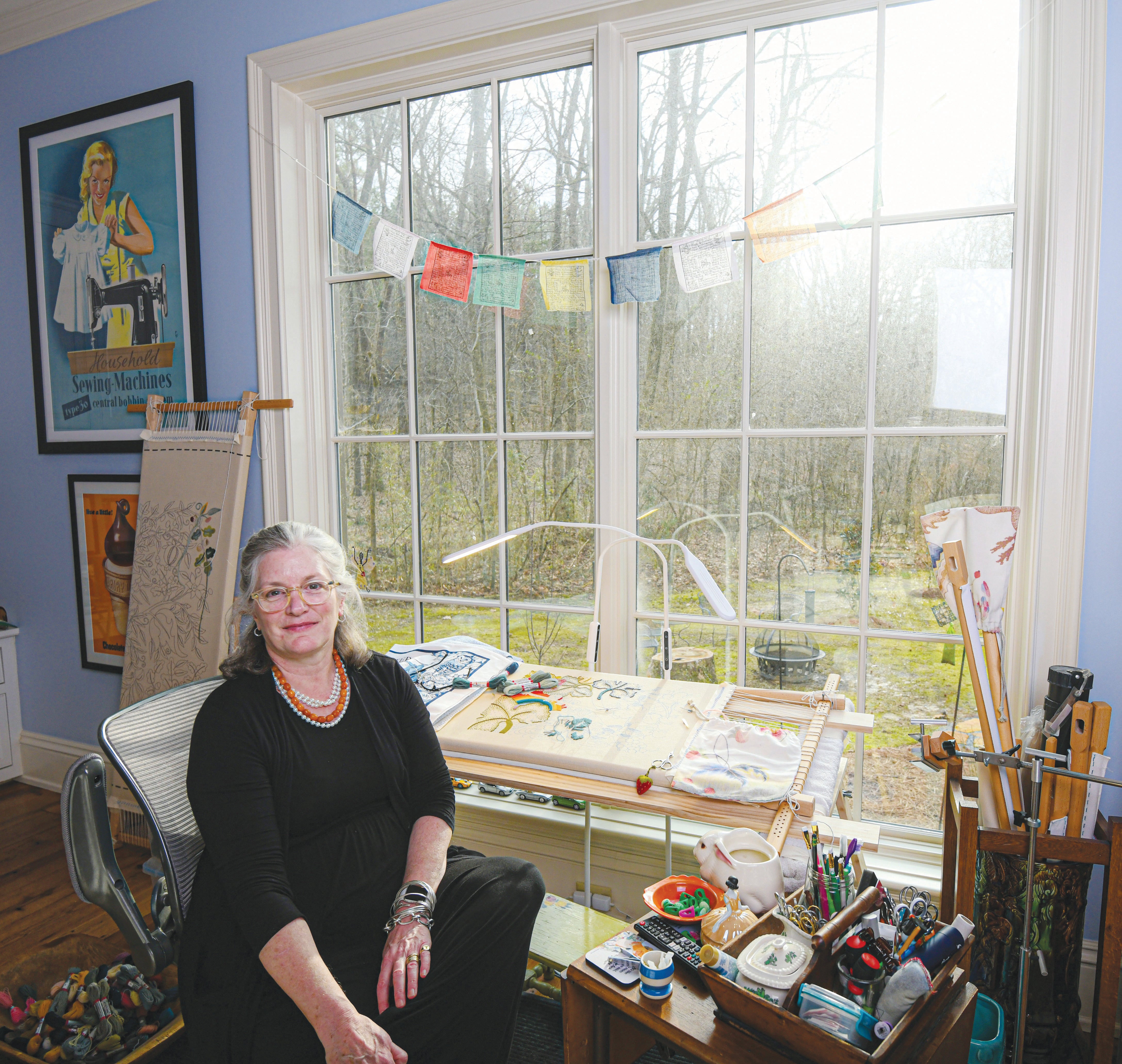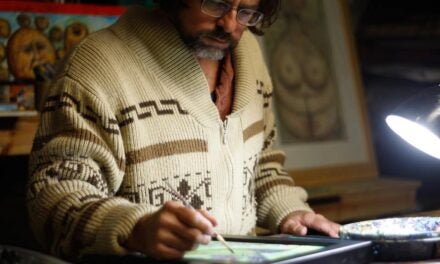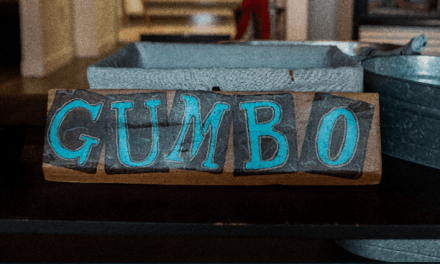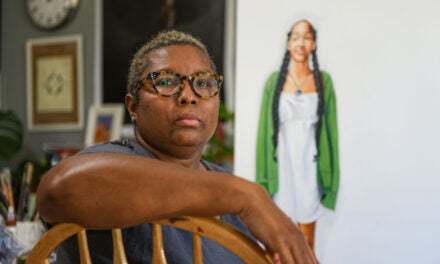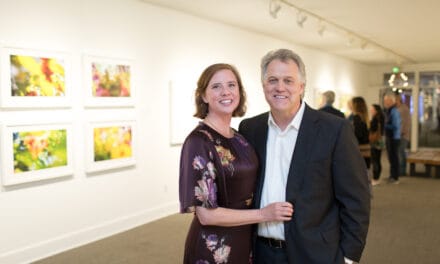By Julie Mabus
An evening at the Oxford home of Harriet and Stephen Roberts is the essence of elegance and whimsey. Fresh-cut flowers crown every surface, dazzling and eclectic artwork covers each wall, appetizers, drinks magically appear, and the music, (think of “Dancing in the Moonlight” by King Harvest). All this before Harriet serves her meal which are always showstoppers and her desserts which one speaks of in hushed tones. But today, I went with an agenda. I was to learn about the extraordinary art of crewel embroidery.
Thirty-five years ago, Harriet and Stephen moved from her Cambridge, Massachusetts birthplace to Brandon, Mississippi, Stephen’s hometown. They met when Stephen was at Harvard Law School. Eventually, Stephen brought his young bride to Mississippi where he began his law career.
Harriet joined the executive staff of Mississippi Governor Ray Mabus. Her cultural transition was a bit daunting. She witnessed state legislators grousing about the unacceptable end of the Civil War, a conflict she couldn’t understand. Her ancestors, John Hancock and William Dawes (who rode with Paul Revere) fought for a different cause.
I met Harriet shortly after the couple moved to Mississippi in 1988. She was shy and self-effacing, but a twinkle lay beneath that calm exterior. Among her many talents, she was an artist with a needle and thread and, in time, created smocked dresses and intricate costumes for my girls.
Two years ago Stephen, now a venture capitalist, fulfilled a promise and the couple bought a home in Oxford with a custom designed space for Harriet, a crewel embroidery studio. I had no idea of the genesis and scope of her talent until I attended one of their dinner parties. Harriet pointed to a remarkable piece of embroidery, “Tati did that one. She inspired me.” I made a mental note to ask.
Today, Harriet answered my questions. We talked for hours as she made a batch of butternut squash soup and a skillet of cornbread with two adoring Westies at her feet.
“Tati is my grandmother, my mother’s mother,” she responded. It became evident Harriet’s love of stitchery, art, cooking, and entertaining evolved through her close relationship with her grandmother and the early years she spent with Tati in Massachusetts.
Tati was Katharine Howe, born in Marblehead, Massachusetts, into a family of wealth and privilege. In her teens, Katharine met an Englishman, Christopher Jerome Teesdale Baker-Carr, at a country dance. Three years later, Katharine packed up her cello and sailed to England, where she and Christopher married in 1926. Displeased, her parents disowned her. Janet, Harriet’s mother, was one of three born of the union.
As armed tension mounted in Europe in the 1930s, Christopher retreated from the family to a military post in Africa. Katharine, who had given up her life of privilege, raised her children alone in Betchworth, a small town south of London, with very little help from her American family. But in those war-torn years, Katharine rediscovered her artistic talents.
After France fell to Germany in June of 1940, Hitler determined to gain air supremacy over Britain in his plot to seize Russia, his next big prize. But he underestimated the will of the British people. The Battle of Britain, a military campaign fought entirely in the air, changed the course of World War II. But the bombings laid waste not only to London but the path leading out of the country as the Luftwaffe dumped their bombs to lighten their loads on their return trip to European air bases. Betchworth was on that path.
Katharine and the children picked up the pieces after two bombings of their home, but the psychological scarring was not so easily mended. Katharine used her artistic talents to salve her wounds with her cello, grand piano, hand-painted tole trays, and crewel embroidery.
The end of World War II was both gut-wrenching and liberating for Katharine. After a six-year separation, her husband Christopher returned home, but he wanted a divorce. Katharine reconciled with her parents and moved back to Massachusetts with her two girls. Katharine later met and married Walter D. Edmonds, a prolific writer of some thirty-four books, including ”Drums Along the Mohawk”, restoring Katherine to the lifestyle she had enjoyed half a lifetime before. Dinner in the home of Walter and “K” Edmonds became a much sought-after invitation with her gourmet cooking and incredible warmth in entertaining.
Harriet’s mother, Janet Baker-Carr, beautiful and talented, turned her energies to modeling, acting, writing, and classical music broadcasting (later Music Director for Public Radio Mississippi). She married and raised two daughters, Harriet and Kate, in Cambridge, Massachusetts, a short distance from Tati. Harriet absorbed the beauty of her grandmother’s stitching from an early age. “I think crewel had always been a part of my growing up, like the memory of Tati’s astonishing and ‘untouchable’ crewel armchair.”
In 2009, after teaching stitchery for over twenty years, Harriet turned her attention to Tati’s love—the thousand-year-old art of crewel work. “I was determined to learn how to stitch properly, but nobody does crewel embroidery in this country, so I searched the Internet and found Phillipa Turnbull.” Phillipa is a British scholar and extraordinary artisan in historical embroidery. She hails from a small village in northern England and has created and sold historically accurate crewel work kits for over twenty years.
Historical accuracy is a vital attribute of this art form. The oldest surviving crewel work embroidery is the Bayeaux Tapestry (though, technically, not a tapestry), a wall hanging depicting the Norman Conquest of 1066. By the 17th century Jacobean era (James 1st of England), the wealthiest and most prestigious families demanded intricate and opulent embroideries, such as wall or bed hangings. In homes, women were the embroiderers. But professionally, men designed and produced the lavish work.
Historical accuracy was a characteristic Harriet admired in Phillipa. “We hit it off instantly, and, within several years, I became Phillipa’s exclusive tester for her kits.” One of their first and most significant projects was a bedhanging at Muncaster Castle in Ravensglass, England. With permission from the Pennington family, who have lived in the castle since 1208, Phillipa used the centuries-old bedhanging to recreate the pattern. After covering it with acetate, she traced the designs with a black marker. She then put linen fabric on the acetate with light below and drew the design from the acetate onto the linen.
The original design of the bedhanging is a Jacobean interpretation of the “Tree of Life. Evocative images of overflowing pomegranates and lilies extending their generative parts anoint the image. Desert and forest animals overrun the tendrils and roots of the tree. It is a masterpiece.
When Harriet received the oversized box from Phillipa filled with the 60 x 72 inch linen fabric on which Phillipa had drawn the finished design, 105 hanks of wool (11 miles in length), and no instructions, Harriet’s magic began. After two years, using photographs of the original bedhanging and the help of a custom-made embroidery slate frame, Harriet completed the stitch instructions for this massive kit.
At last count, The Crewel Work Company has sold nearly one hundred Muncaster bedhangings. In addition to the Muncaster design, Phillipa has created over fifty different embroidery kits. And Harriet has stitched them all.
One last story about Harriet’s remarkable talents is a stunning example of her life experiences. Before Harriet and Stephen married, she lived a year with her grandmother, Tati, in Concord, Massachusetts. Because Tati could no longer cook and entertain the way she once had, she asked Harriet to prepare and serve a meal for a dinner party of six. Harriet prepared pork tenderloin, new potatoes, asparagus, and chocolate cake. When the guests arrived, Harriet heard a distinctive voice. It was Julia Child. I asked Harriet how Julia enjoyed the meal. Harriet laughed, “She cleaned her plate.”

